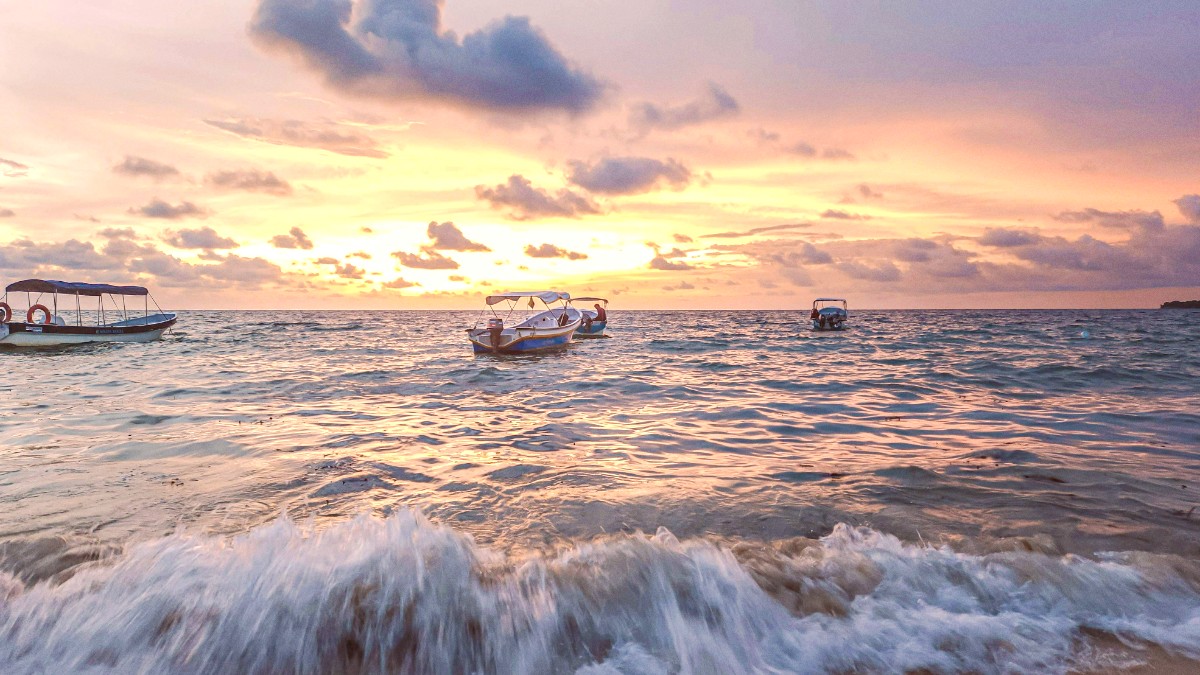
The Coast, Kenya
Average daily temperatures typically range from 25°C to 30°C (77°F to 86°F). Nighttime lows rarely drop below 20°C (68°F), ensuring warm evenings. Humidity stays high throughout the year, frequently exceeding 70-80 percent. A consistent sea breeze moderates temperatures along the coast, offering some relief from the humidity, especially closer to the ocean.
Mombasa experiences two distinct rainy seasons. Long Rains occur from April to June, with May being the month with the heaviest rainfall. These rains can be intense. Short Rains arrive from October to December. This season brings lighter and less predictable showers, often occurring in the late afternoon.
Mombasa does not experience hurricanes or monsoons. However, the "long rains" from April to June can bring very intense downpours, leading to localized flooding and temporary disruption of roads.
The period from February to April, even outside the main rainy season, can be extremely hot and humid. Consider packing for Sun protection.
April - June
Significant savings on travel costs; very low tourist numbers; lush, green landscape.
Heavy rainfall and high humidity; rough seas limit beach activities; some smaller businesses may close.
March, November - December
Fewer crowds; slightly lower prices for flights and lodging; mostly good weather.
March can be very hot; November/December may experience short, intense showers.
July - October, January - February
Drier weather; lower humidity; ideal for beach activities; excellent water visibility.
Higher prices for flights and accommodation; more visitors at attractions, larger crowds.
The high season brings drier weather and lower humidity. Skies are generally clear, providing ideal conditions for beach activities like swimming, sunbathing, snorkeling, and diving. Water visibility for marine activities is excellent. If you combine your coastal trip with a safari, wildlife viewing also goes well during these months, as animals gather around dwindling water sources.
For a comfortable visit, aim for the high season if budget permits. If you seek fewer crowds and better value, the shoulder season presents a good balance. Low season offers significant savings on travel costs, but heavy rainfall and high humidity remain present.
Heavy downpours, localized flooding possible.
Can be extremely hot and humid.
Mombasa does not experience these.
Consider low season for lowest prices.
Animals gather at dwindling water sources in the dry season.
A smooth entry into Kenya starts with understanding the visa and documentation requirements. Most nationalities obtain an e-Visa before arriving.
Most tourists require an e-Visa. Apply for your e-Visa entirely online through the official eCitizen portal (Evisa.go.ke).
When applying for your e-Visa and upon arrival, prepare the following documents. These items support your travel plans and identity.
No general special permits are needed for exploring Mombasa city beyond the standard visa requirements. However, specific areas have entry fees.
The official currency is the Kenyan Shilling (KES). Banknotes come in values of 50, 100, 200, 500, and 1000 KES. Coins circulate in 1, 5, 10, and 20 KES.
The exchange rate fluctuates. As of late 2023/early 2024, approximately 1 USD equals 140-150 KES. Always check current rates before your travel. Easily exchange major currencies like USD, EUR, and GBP at banks and authorized forex bureaus. Avoid unofficial money changers.
Stay in hostels/budget guesthouses, use local transport (matatus, tuk-tuks), eat street food/local eateries ("vibandas").
Daily Cost: KES 4,000 - 8,000 (USD 25-55)
Excludes major safari costs.
Stay in 3-4 star hotels, use a mix of local transport and ride-sharing, dine at mid-range restaurants.
Daily Cost: KES 8,000 - 20,000 (USD 55-135)
Daily costs include accommodation, meals, local transport, and some activities.
Opt for 5-star resorts, private transfers, fine dining, and curated experiences.
Daily Cost: KES 20,000+ (USD 135+)
These estimates exclude major safari costs.
| Category | Item | Price Range (KES/USD) |
|---|---|---|
| Accommodation (per night) | Hostel Dorm Bed | KES 1,000-2,500 (USD 7-17) |
| Mid-range Hotel/Resort | KES 6,000-15,000 (USD 40-100) | |
| Meals | Street Food/Local Eatery | KES 200-800 (USD 1.50-5.50) |
Careful preparation helps avoid common travel issues.
If arriving from or transiting through a high-risk country, carry original certificate.
Hepatitis A & B, Typhoid, TDAP, MMR, Polio, Rabies (if interacting with animals).
Mombasa is a malaria-risk area. Your doctor advises on anti-malarial medication.
Prevention is for a healthy trip.
Malaria: Use Mosquito repellent (DEET, picaridin like Sawyer Products Picaridin Insect Repellent), sleep under nets, wear long sleeves during dusk/dawn.
Traveler's Diarrhea: Practice strict food/water hygiene. Pack Anti-diarrheal medication (Imodium A-D Caplets). Oral rehydration salts prevent dehydration.
Sunburn/Heatstroke: Use High-SPF sunscreen, wear a Wide-brimmed hat (Columbia Bora Bora II Booney Hat), stay hydrated with bottled water.
Private hospitals like Aga Khan Hospital Mombasa generally offer better facilities.
Available in urban areas. Carry copies of prescriptions.
Police/Ambulance/Fire: 999 or 112 (from any local mobile phone).
Mombasa is safe for tourists, but petty crime like pickpocketing occurs in crowded areas. Maintain awareness.
Mombasa does not experience hurricanes or monsoons. However, tropical conditions bring specific seasonal hazards.
Heavy rains (April-June) can cause localized flooding, temporarily affecting roads.
Intense heat and high humidity can lead to heat exhaustion. Drink plenty of fluids.
Be aware of strong ocean currents, jellyfish, or stonefish. Wear Water shoes on rocky beaches.